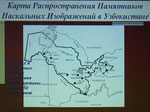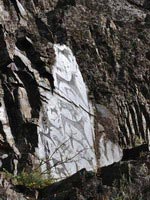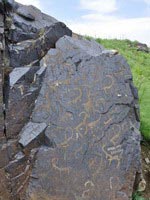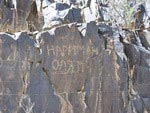Category: Tourism
 On 18 April – the International Day for Monuments and Sites - Advantour received one of the most respected petroglyph experts of Uzbekistan Mukhitdin Khujanazarov, Candidate of Archeological Sciences.
On 18 April – the International Day for Monuments and Sites - Advantour received one of the most respected petroglyph experts of Uzbekistan Mukhitdin Khujanazarov, Candidate of Archeological Sciences.
During the hour and a half lecture the professor introduced the tour agency staff into the famous places of Uzbekistan, where they discovered cave paintings of ancient people, the places of archaeological research and conservation of those unique natural monuments.
 Petroglyphs are images created by carving, engraving on the surface of the stone by a hard object, therefore they do not include images made by painting or other means. The people of past eras preserved in the stone the images of extinct animals that lived in the territory of Uzbekistan during that period, as well as hunting scenes and rituals.
Petroglyphs are images created by carving, engraving on the surface of the stone by a hard object, therefore they do not include images made by painting or other means. The people of past eras preserved in the stone the images of extinct animals that lived in the territory of Uzbekistan during that period, as well as hunting scenes and rituals.
The oldest rock engravings in Uzbekistan were discovered in Teshik Tash cave (Surkhandarya region) in the 1940s. Petroglyphs date back to the late Paleolithic era and were made at least 15 thousand years ago. To this day they are the oldest petroglyphs found in the territory of Central Asia.
 In total, over 150 sites with petroglyphs were discovered on the territory of Uzbekistan. Most of them are concentrated in the Tashkent oasis, the Ferghana Valley, Western Tien Shan.
In total, over 150 sites with petroglyphs were discovered on the territory of Uzbekistan. Most of them are concentrated in the Tashkent oasis, the Ferghana Valley, Western Tien Shan.
Also, the petroglyphs were discovered in South Chatkal, Beldersay, as well as on the banks of Chatkal, Ugam, Pskem in upstream Karakiyasay in Khodjikent, in Ukhum and Sentyab villages in Nuratau mountains. The petroglyphs of Sarmishsay in the Navoi region gained huge popularity.
The examination of most of these sites continues to this day, the processes of preservation of the petroglyphs, protection from human impact are underway. Today, dozens of tourists from around the world come to learn not only the Eastern medieval exoticism of Samarkand, Bukhara, Khiva, but also the ancient petroglyphs of Khodjikent, Beldersay and Sarmishsay.
 Each petroglyph can tell us the whole story. The detailed study of images gives raise to dozens of question.
Each petroglyph can tell us the whole story. The detailed study of images gives raise to dozens of question.
For example, why are there ancient images of chariots in the mountains where they basically could not go? Why are people depicted with clamped noses at the petroglyphs portraying a ritual of sacrifice? Why are some people shown without heads and hands?
The answers to these questions provides better understanding of the world of primitive man, helps us to trace the link of times and analyze the human development during the period from the Paleolithic to the Early Middle Ages.
 Conservation of rock engravings is a serious problem now. Many of the petroglyphs, especially those located far from populated areas, are damaged by vandals who scratch their names or use resistant inks to make inscriptions on top of ancient petroglyphs.
Conservation of rock engravings is a serious problem now. Many of the petroglyphs, especially those located far from populated areas, are damaged by vandals who scratch their names or use resistant inks to make inscriptions on top of ancient petroglyphs.
A few minutes to draw, the paint is extremely difficult to remove, it takes many hours or even days of hard work and the use of special equipment. The government takes steps to protect sites with petroglyphs, rangers and inspectors keep watch on the sites of petroglyphs, they conduct outreach to the population, but, unfortunately, this is not always enough to stop a bully with a spray paint.

